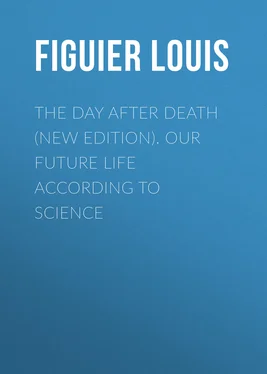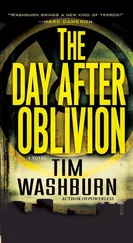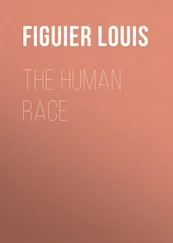Louis Figuier - The Day After Death (New Edition). Our Future Life According to Science
Здесь есть возможность читать онлайн «Louis Figuier - The Day After Death (New Edition). Our Future Life According to Science» — ознакомительный отрывок электронной книги совершенно бесплатно, а после прочтения отрывка купить полную версию. В некоторых случаях можно слушать аудио, скачать через торрент в формате fb2 и присутствует краткое содержание. Жанр: Эзотерика, foreign_religion, foreign_antique, foreign_prose, на английском языке. Описание произведения, (предисловие) а так же отзывы посетителей доступны на портале библиотеки ЛибКат.
- Название:The Day After Death (New Edition). Our Future Life According to Science
- Автор:
- Жанр:
- Год:неизвестен
- ISBN:нет данных
- Рейтинг книги:5 / 5. Голосов: 1
-
Избранное:Добавить в избранное
- Отзывы:
-
Ваша оценка:
- 100
- 1
- 2
- 3
- 4
- 5
The Day After Death (New Edition). Our Future Life According to Science: краткое содержание, описание и аннотация
Предлагаем к чтению аннотацию, описание, краткое содержание или предисловие (зависит от того, что написал сам автор книги «The Day After Death (New Edition). Our Future Life According to Science»). Если вы не нашли необходимую информацию о книге — напишите в комментариях, мы постараемся отыскать её.
The Day After Death (New Edition). Our Future Life According to Science — читать онлайн ознакомительный отрывок
Ниже представлен текст книги, разбитый по страницам. Система сохранения места последней прочитанной страницы, позволяет с удобством читать онлайн бесплатно книгу «The Day After Death (New Edition). Our Future Life According to Science», без необходимости каждый раз заново искать на чём Вы остановились. Поставьте закладку, и сможете в любой момент перейти на страницу, на которой закончили чтение.
Интервал:
Закладка:
There exists in man three elements:—
1. The body, or the material substance.
2. The Life, or as Barthez calls it, the Vital Force .
3. The Soul, or as Lordat calls it, the Intimate Sense .
We must not confound the soul with the life, as the materialists and certain shallow philosophers have done. The soul and the life are essentially distinct. The life is perishable, while the soul is immortal; the life is a temporary condition, destined to decline and destruction; while the soul is impervious to every ill, and escapes from death. Life, like heat and electricity, is a force engendered by certain causes; after having had its commencement, it has its termination, which is altogether final. The soul, on the contrary, has no end.
Man may be defined as a perfected soul dwelling in a living body .
This definition permits us to specify what it is that constitutes death.
Death is the separation of the soul and the body. This separation is effected when the body has ceased to be animated by the life.
Plants and animals cannot live except under certain conditions: plants in the air or in the water, animals in the air, fish in the water; and if they are deprived of these conditions, they perish immediately. Again, there are existences which require special conditions for their support within the general ones.
Certain polypoid-worms can live only in carbonic acid, or azotic gas; the germs of cryptogams produced by damp can be developed only in aqueous infusions of vegetable matters; the fish which live in the sea, die in fresh, or only moderately salt, water.
Every living being has then its special habitat . The soul does not form an exception to this rule. The place, the habitat of the soul is a living body. The soul disappears from the body when this body ceases to live, just as a man forsakes a house when that house has been destroyed by fire.
Such is the doctrine of the triple alliance of the body, the soul, and the life, as formulated by the School of Montpellier, and such, as a consequence of this doctrine, is the mechanism of death.
It must be added that this triple alliance of the body, the soul, and the life, is not peculiar to man; it exists also in all animals. The animal has also a living body, and soul; but the soul in animals is much inferior to the soul in men, in the number and extent of its faculties. Having few wants, the animal has a very small number of faculties, which are all in a rudimentary condition. It is only in the very considerable development of the faculties of the soul that man differs from the superior animals, to which he bears a strong resemblance in his physiological functions, and his anatomical structure.
It must be remarked that the Montpellier School does not admit this view of the condition of animals. In another part of this work, 1 1 Ch. XV .
a fuller explanation of the distinctions which divide man from animal will be found.


CHAPTER THE SECOND
AFTER death, the body, whether of a man, or of an animal, being no longer preserved from destruction by vital force, falls under the dominion of chemical forces. If the body of a dead animal, or a human corpse be kept in a place where the temperature is below 0°, or if it be shut up in a space entirely air-tight, or if it be impregnated with antiseptic substances, it will remain intact, as at the moment at which life has abandoned it. Such is the process of embalming. The effect of the various chemical substances with which a corpse is impregnated, is to coagulate the albumen of the tissues, and thus to preserve the animal substance from putrefaction. A similar result will be obtained if the corpse be placed between two layers of ice, or in a coffin entirely surrounded with ice constantly renewed. If kept at a temperature of 0°, the body will not be subject to decomposition, because putrid fermentation cannot take place at so low a temperature.
This was the process by which the entire carcasses of the mammoths, or extinct elephants, which belonged to the quaternity period, were preserved. In 1802 a perfectly preserved carcass of this gigantic pachyderm was found on the bank of the Lena, a river which runs into the Arctic Sea, after traversing a portion of the Asiatic continent in the vicinity of the North Pole. The frozen earth and the ice which covers the banks of the river into which the mammoth had plunged, had so effectually preserved it from putrefaction, that the flesh of the huge creature, dead for more than a hundred thousand years, made a feast for the fishermen of that desert place. In northern countries, if one would preserve the body of a man, it could be effectually done by simply keeping it constantly wrapped in ice.
When the body of a man, or of an animal, is exposed to the combined influences of air, of water, and of a moderately high temperature, it undergoes a series of chemical decompositions, whose final term is its transformation into carbonic acid gas, and some compounds, gaseous or solid, which represent the less advanced products of destruction. Gases of various kinds, carbonic acid, hydrosulphuric, and ammoniac, and the vapour of water, spread themselves through the atmosphere, or dissolve into the humidity of the soil. At a later stage these compounds, thus dissolved into the water which bathes the earth, are absorbed by the little roots of the plants which live on it, and aid in their nutrition and development. As for the gas, it begins by spreading through the air; and then falling to the earth again dissolved in the rainwater, it also equally supplies the needs of vegetable life. The ammoniac and carbonic acid in the water which penetrates the soil, is absorbed by the roots, introduced into the tubes of the plants, and supplies them with nourishment.
Thus, the matter which forms the bodies of men and animals is not destroyed; it only changes its form, and under its new conditions it aids in the composition of fresh organic substances.
In all this the human body does but obey the common laws of nature. That which it undergoes, every organized substance, vegetable or animal, exposed to the combined influences of air, water, and temperature, equally undergoes. A piece of cotton or woollen stuff, a grain of wheat, a fruit—they all ferment, and reduce themselves to new products, exactly as our bodies do. The cere cloth which enfolds a corpse is destroyed by precisely the same process which destroys the corpse.
But, if the material substance which forms man's body does but transform itself, journeying through the globe, passing from animals to plants and from plants to animals; it is quite otherwise with life. Life is a force. Like the other forces, heat, light, and electricity, it is born, and it transmits itself; it has a beginning and an end. Like light, heat, and electricity—the physical agents which make us comprehend life, and which have certainly the same essence and the same origin—life has its producing causes, and its causes of destruction. It cannot rekindle itself when it has been extinguished; it cannot re-commence its course when its fatal term has arrived. Life cannot perpetuate itself; it is a simple condition of bodies, a fugitive and precarious condition, subject to countless influences, accidents, and chances.
The life is therefore greatly inferior in importance to the soul, which is indestructible and immortal. The soul is the essential element in all nature. It has active and positive qualities in all respects where the two other elements, the body and the life, have only negative qualities. Whilst the body dissociates itself and disappears, while the life becomes annihilated, the soul can neither disappear nor become annihilated.
Читать дальшеИнтервал:
Закладка:
Похожие книги на «The Day After Death (New Edition). Our Future Life According to Science»
Представляем Вашему вниманию похожие книги на «The Day After Death (New Edition). Our Future Life According to Science» списком для выбора. Мы отобрали схожую по названию и смыслу литературу в надежде предоставить читателям больше вариантов отыскать новые, интересные, ещё непрочитанные произведения.
Обсуждение, отзывы о книге «The Day After Death (New Edition). Our Future Life According to Science» и просто собственные мнения читателей. Оставьте ваши комментарии, напишите, что Вы думаете о произведении, его смысле или главных героях. Укажите что конкретно понравилось, а что нет, и почему Вы так считаете.












